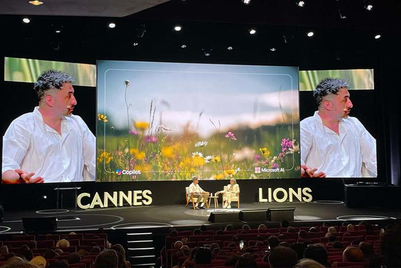
Cannes Lions 2025 didn’t feel like a creative festival. It felt like an industry reckoning. This year wasn’t about which brand cried the loudest or which case study had the slickest transitions—it was about where marketing is headed next, and who’s actually equipped to get there. Spoiler: it’s not who you think.
Here are five takeaways that stuck.
1. AI is the corporate Ozempic
AI isn’t coming for your job. It’s coming for your inefficiencies.
Just like Ozempic didn’t replace people, it reshaped them. You feel more beautiful, people respond to that beauty. AI is doing the same to our industry. Clients are no longer impressed by bloated headcounts or massive FTE rosters. They are starting to ask better questions, like how much revenue is processed per employee. I stole the phrase from Scott Gallaway - thanks Scott.
That question alone favors independent agencies with real output over large agencies with inflated teams. Many shops are already onboarding AI "employees" to improve profitability without increasing staff. It is not about replacement. It is about results. If you are not adding value to performance or revenue, your seat may start feeling optional.
2. Where was Asia?
For a region that drives global culture, Asia felt noticeably absent from Cannes this year. Saw a lot of LATAM, which is good. Beyond a strong showing from Dentsu and a few entries from India, there was little visibility from China, Singapore, Korea, Southeast Asia, or Hong Kong.
Ten years ago, you could feel Asia’s creative energy. This year, not so much. It’s not about attendance. It’s about participation. Where are the submissions? Where are the regional narratives? This isn’t a Cannes problem alone. It is a wake-up call for the region to return to the global creative stage. Reviving platforms like Young Lions or Cannes Lions Asia would help, but ambition and consistency must come from the agencies and brands themselves.
3. The CMO must own revenue
This was the year CMOs stopped being storytellers and started becoming operators. The shift was everywhere. If you walked from Amazon Port to Meta Beach to TikTok’s activation, the message was consistent. Brand is important. Sales are mandatory.
CMOs are now expected to own ecommerce, Amazon storefronts, TikTok Shop, affiliate links, and retailer.com performance. No more blurry lines between brand and business. If your campaign doesn’t show up in the sales data, you’re not doing your job.
Tech platforms are making it easier than ever to support retail. Amazon Nova, Meta’s AI-driven ad tools, and influencer-to-store integrations are removing the excuses. The modern CMO needs to act like a chief revenue and digital marketing officer. That title may not exist yet, but the job already does.
4. AI cannot replace stadiums, performers, or Ferragamo-colored Porsches
For all its efficiency, AI still cannot create cultural moments. You can’t program what it feels like to watch a headliner perform in a sold-out arena. You can’t replicate the buzz of a Formula 1 weekend or the surprise of seeing Ferragamo colors offered on a Porsche.
Live entertainment, sports, tourism tie-ins, and brand collaborations owned the conversation at Cannes. These are the experiences AI cannot touch. Yes, technology is helping make these events smarter, from digital signage to custom ad placements during sports broadcasts. But it cannot replace the feeling.
If anything, AI is reinforcing how irreplaceable those moments are. Brand value will increasingly be built through real-world, high-emotion experiences. Expect more mashups between industries, looser licensing rules, and unexpected co-branded moments. That is where culture is headed, and AI will stay on the sidelines.
5. Influencers now drive more spend than paid media
ADVERTISING IS ALSO A $1 TRILLION DOLLAR INDUSTRY, and nearly 58% of that is shifting to content-driven advertising revenue.
There’s no debate anymore. In several major markets, influencer and content collaborations have surpassed paid media as the dominant investment. According to WPP leadership, that moment officially arrived this year.
Influencers are no longer experimental—they’re essential. From macro creators to niche KOLs and KOCs, the ecosystem is delivering more than just impressions; it’s driving conversions. TikTok Shop and Amazon’s influencer program are reshaping the path from discovery to checkout. This model is thriving because it’s efficient, trusted, and deeply embedded in culture.
Mass digital will always have a role, but influence now leads the funnel. Brands are realizing they don’t need to speak to everyone—just to the right communities. That shift isn’t temporary. It’s permanent.
Final thought
Cannes Lions 2025 confirmed that creativity is still alive. But it no longer lives in glossy films or big stages alone. It lives in accountability, in retail performance, in human connection, and in the spaces AI cannot yet reach.
Marketing’s next chapter will be written by those who can blend story, system, and scale. If you are still measuring success by headcount or feel-good metrics, you are already behind.
Humphrey Ho is the CEO of Helios & Partners


.jpg&h=334&w=500&q=100&v=20250320&c=1)


.png&h=334&w=500&q=100&v=20250320&c=1)

.jpg&h=334&w=500&q=100&v=20250320&c=1)
.png&h=334&w=500&q=100&v=20250320&c=1)
.png&h=334&w=500&q=100&v=20250320&c=1)

.png&h=334&w=500&q=100&v=20250320&c=1)

.png&h=268&w=401&q=100&v=20250320&c=1)



.png&h=268&w=401&q=100&v=20250320&c=1)
.jpg&h=268&w=401&q=100&v=20250320&c=1)
